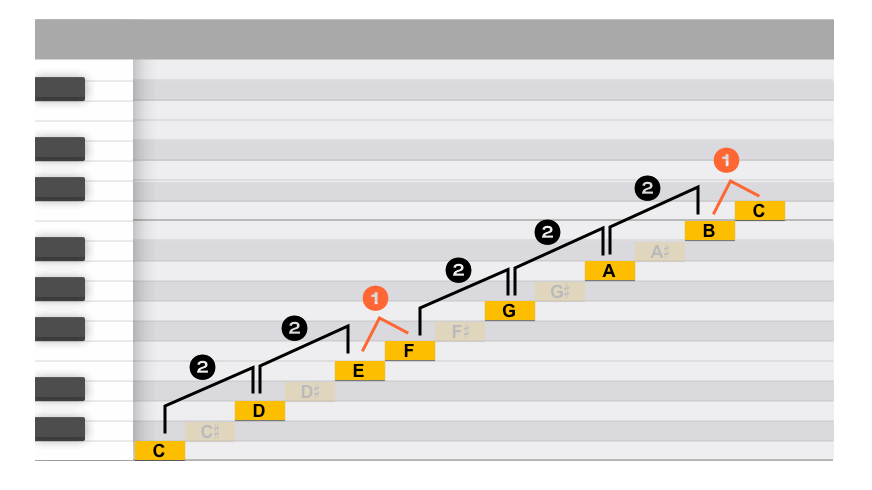Contents
1. All That Matters is Step
In the previous section you saw the mechanism of scales; The arrangement of whole tone and semitone determines the basic sound character of a scale.
Step structure is the definitive factor for its sound, which means that you can construct major scale from any note as the center.
You may have practiced singing like this in music class at school. This is a typical example of playing major scales with different tonal center. The center shifts up and up, but its bright mood remains the same. How can it be done?
To keep the structure “WWSWWWS”, you must combine black keys with white keys.
Construct a Major Scale
Say you want to get a major scale from D, it will be like this:
Thus you can get D major scale. In terms of mood, you won’t notice any difference from C major scale! But its pitches are 2 semitones higher.
It is notable that humans perceive music from relative perspective. This is one of the most intriguing phenomena in music psychology.
Looking Through Piano-Roll
Or this will be better illustrated by piano-roll. Imagine you select all notes and shift them up:
Just press [Ctrl-A][↑][↑] and you’ll get D major scale! To entirely shift up/down a song is called Transposition.
- Transpose
- To entirely shift up/down all the pitches of a song, keeping its relative structure.
- [n.] Transposition
A song is often transposed when a singer cannot sing the song well due to their voice range.
In DAW it’s super easy to transpose, just as you saw above. Guitarists also can transpose their instruments using a capo or down-tuning. Pianists, on the other hand, have to train themselves to be able to play major scales from any note, because there’s no [Ctrl-A] key on a piano!😂
Start from a Black Key
Let’s take another example, setting a black key as tonal center—Like, say, E♭.
This is E♭ major scale, where E, A, B are flattened.
I assume that you’re getting tired of counting WWSWWWS. Don’t worry, I’ll introduce a good cheat-sheet in a later section😇
2. Relative Scales
As pointed out in earlier sections, C major scale and A minor scale consist of exactly the same members.
In this respect they’re closely related, like related by blood. In music theory, this relationship is termed Relative.
- Relative
- [adj.] A term that refers to the relationship between two scales that have the same constituent (but with different tonal center).
Recognition of Scales
A very important notice here is : The distinction between two relative scales are vague since its only difference—the tonal center—is recognized subconsciously by your brain.
As mentioned before, TC is judged by comprehensive situation including melody lines, chord progressions etc. Conversely, Unless melodies or chords clearly emphasize a single note, you cannot judge it!
Above are the examples of ambiguous tonal center songs. Which do you feel on these songs, bright/cheerful or dark/sad? ……I bet you can’t clearly say. It’s alright since they’re by nature vague.
So imagine it like TC is swaying between two positions, creating rather more sensitive mood than simple brightness or darkness.
Finding the Relative
Any major scale has its relative, which you can easily find by just re-setting its center to 2 notes below. Let’s try finding the relative of D major scale.
It is B minor scale. Check out its step structure and you’ll find the DNA of minor scale, “WSWWSWW”.
Review
No matter which note is set as the center, you can make major scales and minor scales by keeping its step structure. Scales other than C major / A minor scales use black keys more or less.
All 12 keys are the candidate for TC so there are 12 major scales, all of which have “WWSWWWS” steps.
And shifting the center of these scales by two notes will make the relative minor scale.
Now you have almost full understanding for the mechanism of scales! the “DNA” for a scale is its steps. And there are “relative” relationship just as humankind.
Summary
- The mood of a scale is determined by the arrangement of whole tones / semitones.
- For example, the sequence for a “major scale” is “WWSWWWS”.
- If the step structure of scales is identical one another, the overall impression will be the same regardless of its tonal center pitch.
- Scales with identical collection of pitches are “relative”.

